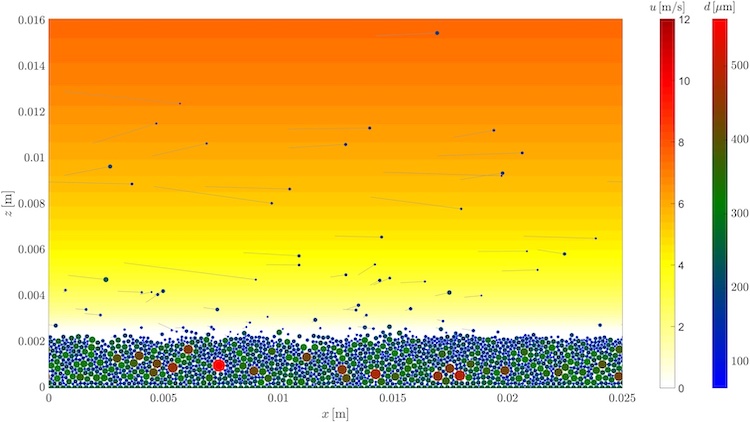G.H.P. Campmans1*, K.M. Wijnberg1
1 University of Twente, *
Introduction
Sediment in coastal dunes are often finer sediment grains than those observed at the beach. Because the sand from the beach is blown to the dunes, there must be sorting processes going on. However, most sediment transport models quantify sediment transport using a single grain size. The goal of this research is to gain insight in the sorting process of aeolian sediment transport by modelling sediment transport at the grain scale.
Methods
To model aeolian sediment transport at the grain level both the grains as well as the airflow needs to be described, similar to e.g. Durán et al. (2012). For the sediment dynamics the Discrete Element Method is used, which models every grains trajectory by the equations of motion. The airflow is modelled using a boundary layer model. Sediment grains experience accelerations through collisions with each other, by gravitational acceleration and by fluid drag forces. Similarly the drag forces accelerating the sediment grains causes the airflow to decelerate. To model the sorting processes in aeolian sediment transport the sediment grains in the bed have grain sizes following prescribed size distributions. By keeping the median grain size (D50) constant in the model simulations and varying the sediment distributions the sorting effect in various sediment compositions is investigated.
Results
The Figure shows a snapshot of particles in transport. Early results confirm that the median sediment grain, D50, indeed quantifies total sediment transport rates accurately for the sediment distributions tested. However, the grain sizes that contribute to the transport rates are generally the smaller grains.

Figure: A snapshot of sand grains in wind-driven saltation transport. The background colour shows the horizontal wind speed ? in the boundary layer. The grains are coloured by their diameter ?. The trailing tails indicate the velocity and direction of particle trajectories.
References
Durán, O., Andreotti, B., Claudin, P., 2012. Numerical simulation of turbulent sediment transport, from bed load to saltation. Physics of Fluids 24, 103306. https://doi.org/10.1063/1.4757662
I. Surname1*, F.N. Another-Surname2 , Y. Next-Surname2
1 University Name, Country; 2 Organization Name, Country
* Corresponding author: mail.name@organization.org


